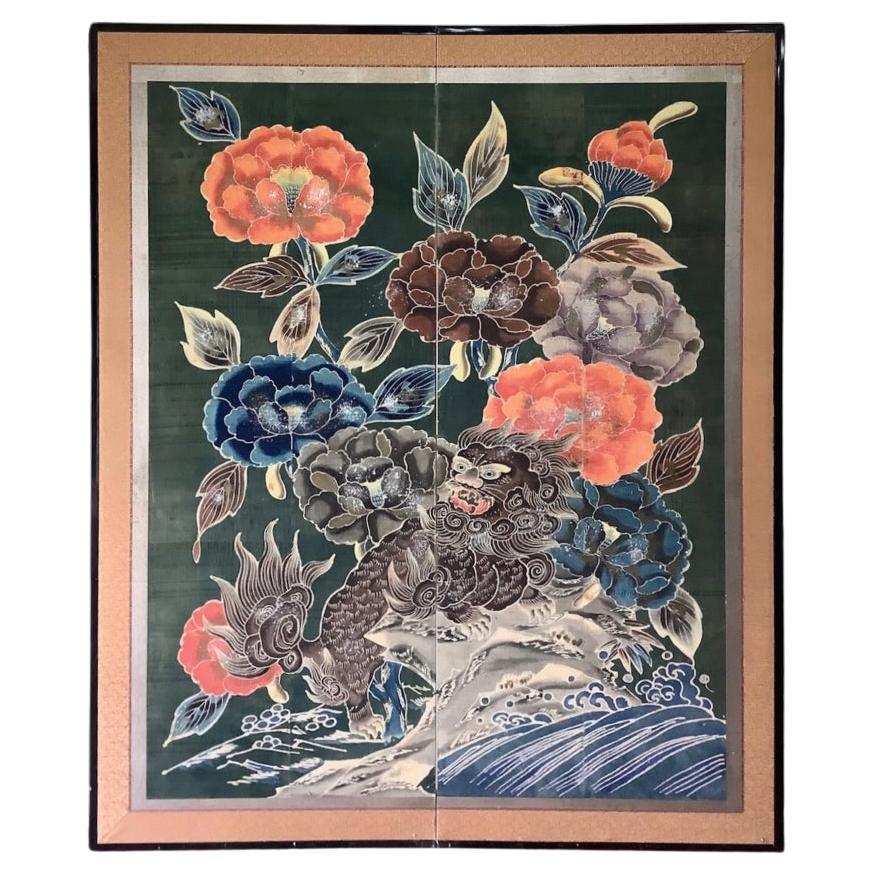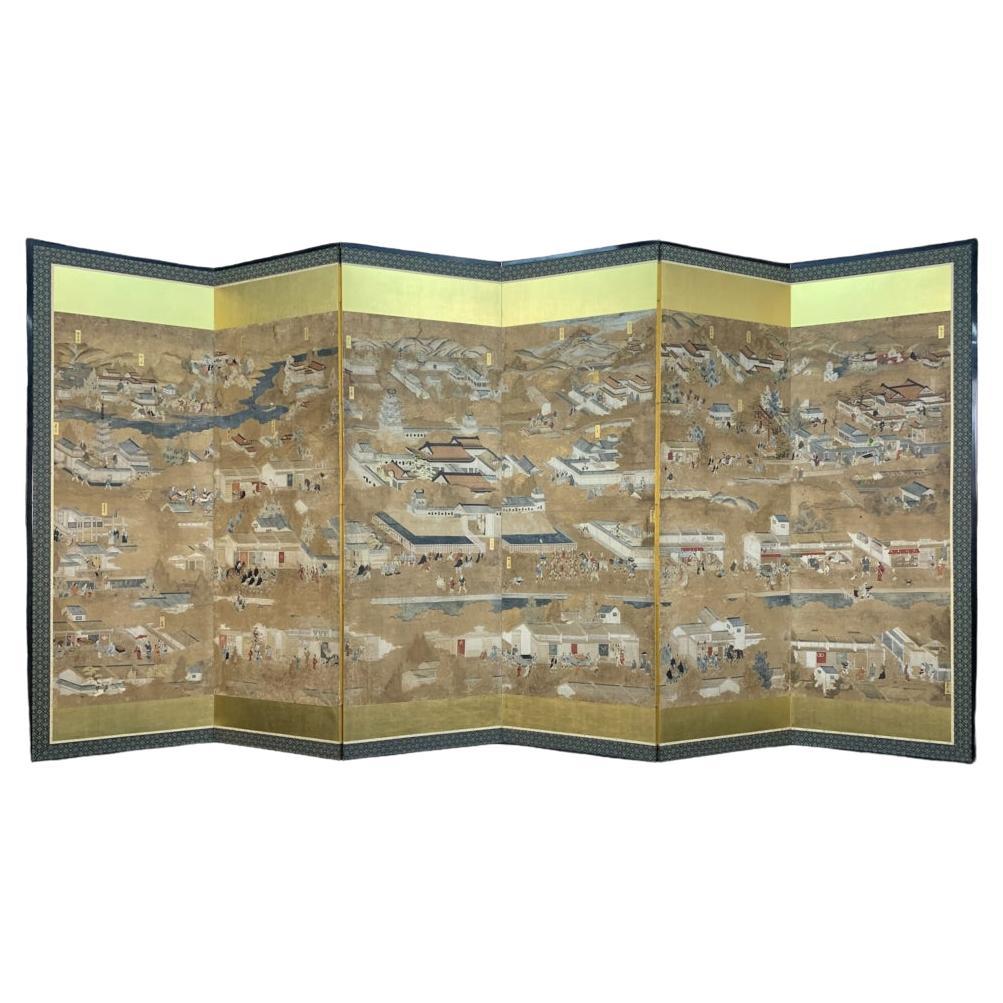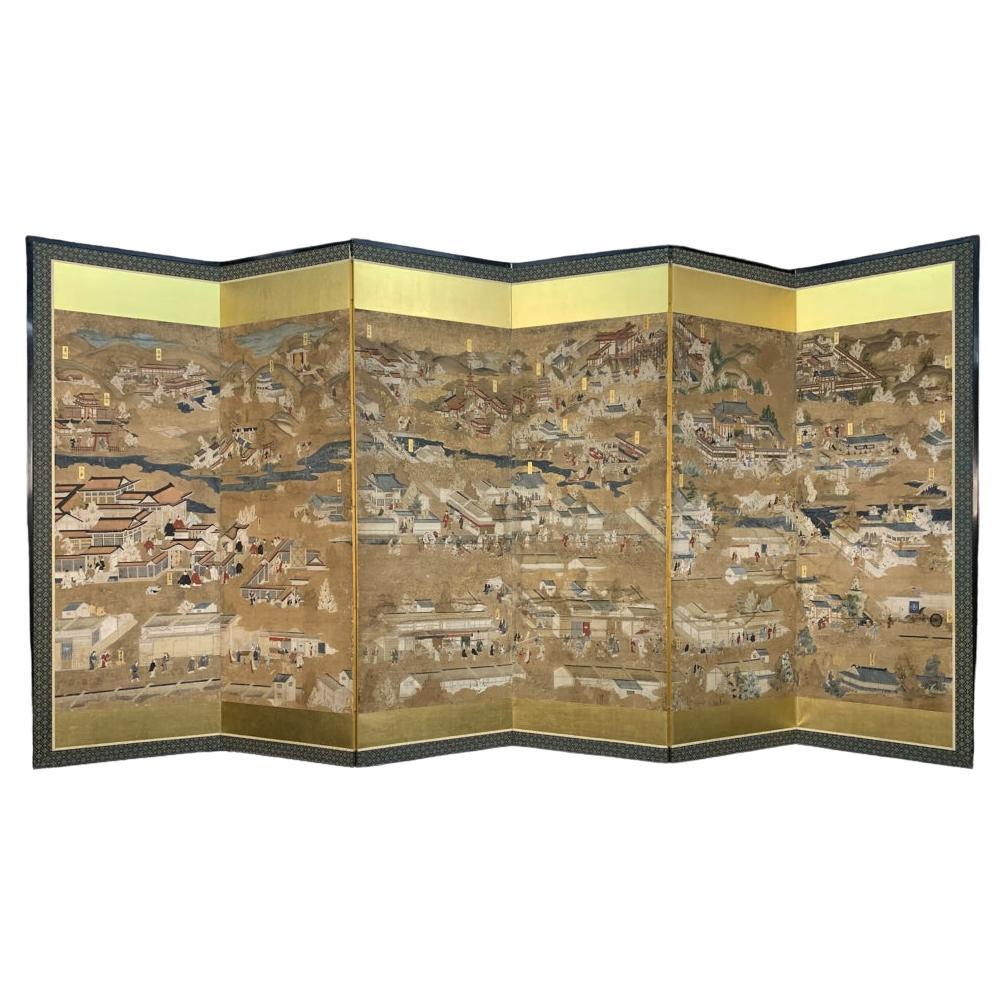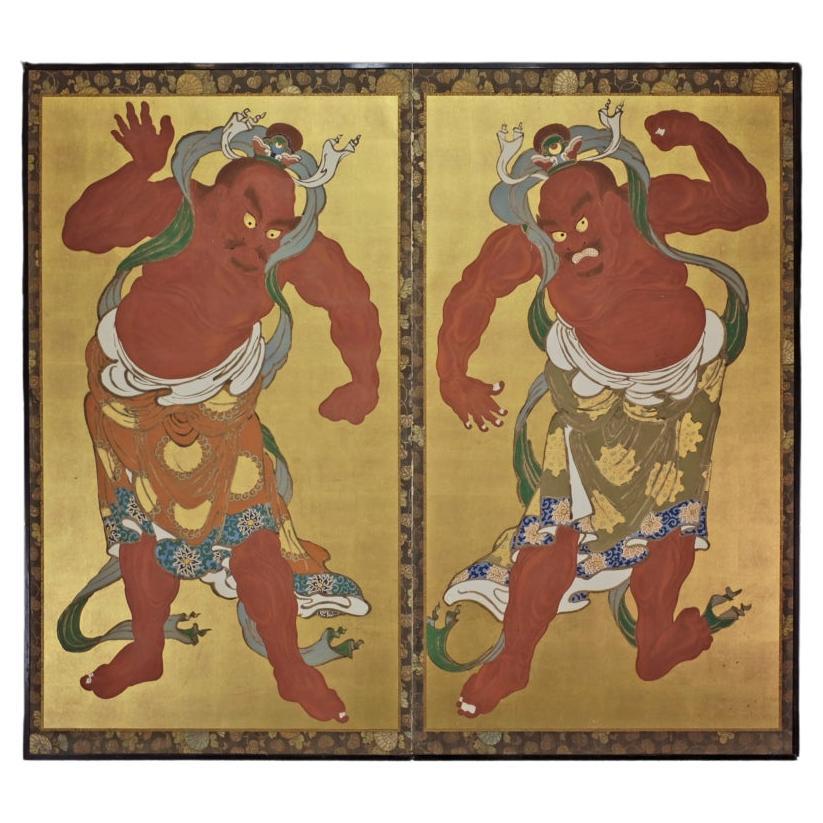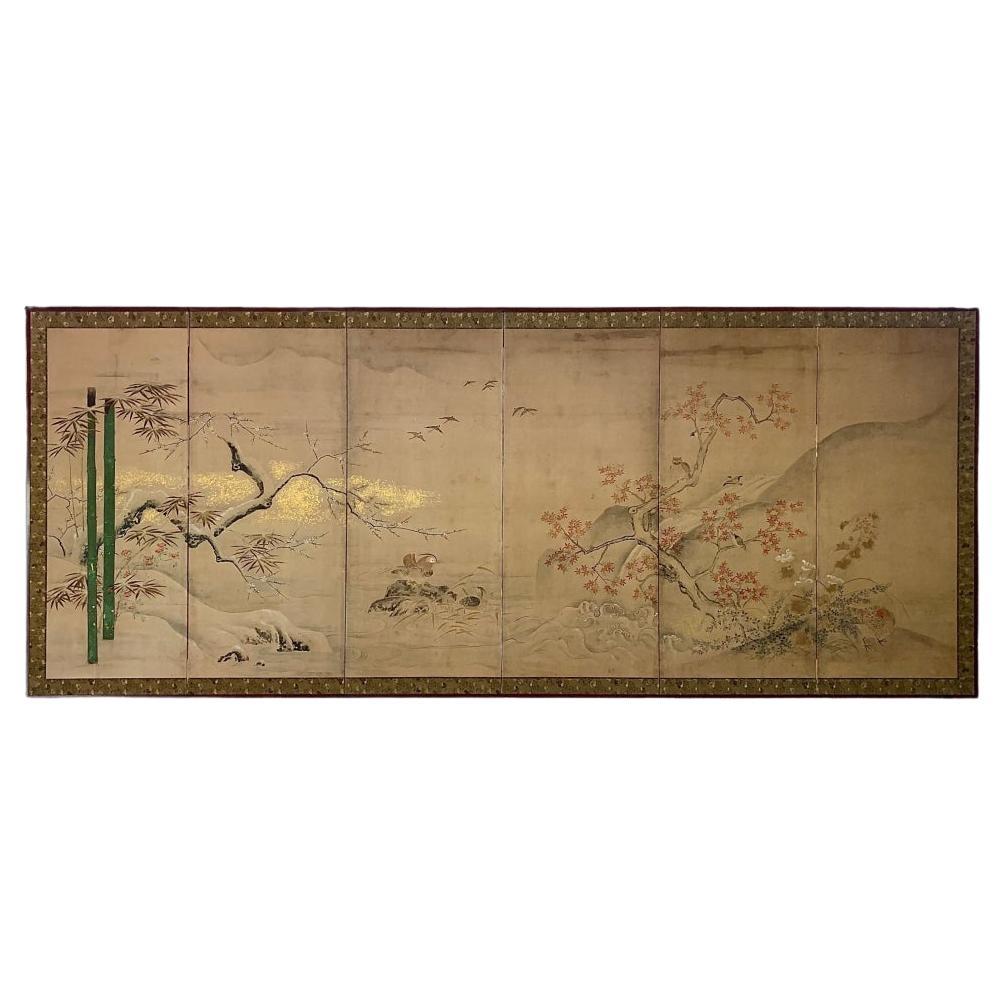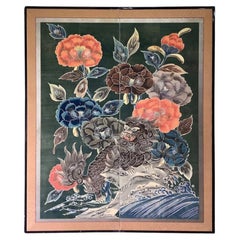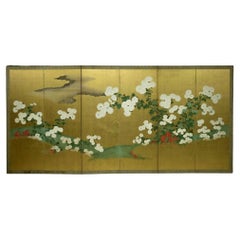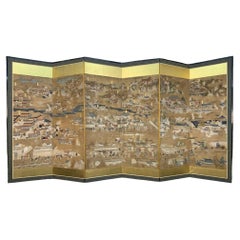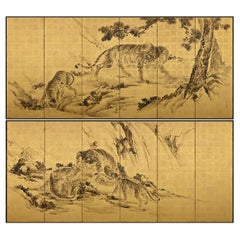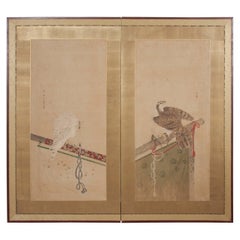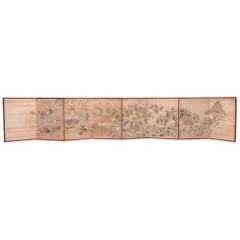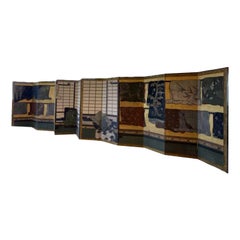Items Similar to Late Edo period Tsutsugaki 筒描 Auspicious Shishi Batik Screen
Want more images or videos?
Request additional images or videos from the seller
1 of 7
Late Edo period Tsutsugaki 筒描 Auspicious Shishi Batik Screen
About the Item
Auspicious Shishi Batik Screen
Period: Late Edo
Size: 145x173 cm (57x68 inches)
SKU: PTA62
Step into the mythical world of late Edo Japan with our radiant batik screen depicting the Shishi, or Japanese mythical lion. This extraordinary piece features a dynamic scene of Shishi leaping amidst waves, surrounded by bold white, dark, and red peonies against a dark green backdrop.
This extraordinary screen is steeped in symbolism. Shishi, revered as the king of beasts, symbolizes strength, courage, and protection, warding off evil spirits. The peony, or Botan, known as the king of flowers, represents prosperity, honor, and nobility. Together, they create an auspicious environment, inviting positivity and blessings into your space.
About the technique:
Tsutsugaki (筒描) is a Japanese technique of resist dyeing that involves drawing rice-paste designs on cloth, dyeing the cloth, and then washing off the paste.[1]
The rice paste is typically made from sweet rice, which has a high starch content and is therefore rather sticky. The paste is applied through a tube (tsutsu) similar to a piping bag. A related process is to apply the paste through a stencil, a technique known as katazome.
The cloth dyed is typically cotton, and the dye is typically indigo, so the design is usually white on blue. Banners for shops or other purposes are sometimes made in this manner.
The designs are often creatures from Japanese mythology such as the crane or the tortoise, or a family crest, or a name (written in kanji). Flowers and trees are common motifs as well.
- Dimensions:Height: 56.3 in (143 cm)Width: 68.9 in (175 cm)Depth: 0.79 in (2 cm)
- Style:Edo (Of the Period)
- Materials and Techniques:
- Place of Origin:
- Period:
- Date of Manufacture:Unknown
- Condition:Condition report upon request.
- Seller Location:Fukuoka, JP
- Reference Number:1stDibs: LU8121239720652
About the Seller
5.0
Gold Seller
Premium sellers maintaining a 4.3+ rating and 24-hour response times
Established in 1998
1stDibs seller since 2023
52 sales on 1stDibs
Typical response time: 3 hours
- ShippingRetrieving quote...Shipping from: Tambon Hang Dong, Thailand
- Return Policy
Authenticity Guarantee
In the unlikely event there’s an issue with an item’s authenticity, contact us within 1 year for a full refund. DetailsMoney-Back Guarantee
If your item is not as described, is damaged in transit, or does not arrive, contact us within 7 days for a full refund. Details24-Hour Cancellation
You have a 24-hour grace period in which to reconsider your purchase, with no questions asked.Vetted Professional Sellers
Our world-class sellers must adhere to strict standards for service and quality, maintaining the integrity of our listings.Price-Match Guarantee
If you find that a seller listed the same item for a lower price elsewhere, we’ll match it.Trusted Global Delivery
Our best-in-class carrier network provides specialized shipping options worldwide, including custom delivery.More From This Seller
View AllLate Edo period Tsutsugaki 筒描 Auspicious Shishi Batik Screen
Located in Fukuoka, JP
Auspicious Shishi Batik Screen
Period: Late Edo
Size: 145x173 cm (57x68 inches)
SKU: PTA62
Step into the mythical world of late Edo Japan with our radiant batik screen depicting the...
Category
Antique 19th Century Japanese Edo Paintings and Screens
Materials
Cotton, Wood
Late Edo Period Rinpa School Chrysanthemum Blossom Screen
By Rimpa School
Located in Fukuoka, JP
Late Edo Period Rinpa School Chrysanthemum Blossom Screen
Period: late Edo, early 19th century
Size: 364 x 172 cm (143 x 67 inches)
SKU: PTA13
This exquisite late Edo period Rinpa ...
Category
Antique 18th Century Japanese Edo Paintings and Screens
Materials
Paper
Edo Period Kyoto Screen
Located in Fukuoka, JP
Edo Period Kyoto Screen
Period: Edo period
Size: 343 x 176 cm (134.6 x 69 inches)
SKU: RJ69
This stunning Edo period screen depicts typical scenes of d...
Category
Antique 18th Century Japanese Edo Paintings and Screens
Materials
Silk, Wood, Paper
Edo Period Kyoto Screen (2/2)
Located in Fukuoka, JP
Edo Period Kyoto Screen
Period: Edo period
Size: 343 x 176 cm (134.6 x 69 inches)
SKU: RJ69/2
This stunning Edo period screen depicts typical scenes of...
Category
Antique 18th Century Japanese Edo Paintings and Screens
Materials
Silk, Wood, Paper
Late Edo Nio Screen
Located in Fukuoka, JP
Late Edo Nio Screen
Period: Late Edo, 19th century
Size: 170 x 190 cm (67 x 75 inches)
SKU: PTA15
This powerful and extremely rare screen depicts the Nio, Buddhist temple guardians...
Category
Antique 19th Century Japanese Edo Paintings and Screens
Materials
Gold Leaf
Edo Period Seasonal Transition Screen
Located in Fukuoka, JP
Edo Period Seasonal Transition Screen
Period: Edo
Size: 368 x 153 cm
SKU: PTA148
This exquisite six-panel screen, adorned with golden flakes, beautifully portrays the seamles...
Category
Antique 19th Century Japanese Edo Paintings and Screens
Materials
Gold Leaf
You May Also Like
Japanese Screen Pair, Tigers by Kishi Renzan, Late Edo Period
Located in Kyoto, JP
Kishi Renzan (1804-1859)
Tigers
Pair of six-panel Japanese screens.
Ink and gold-leaf on paper.
In this monochromatic pair of six-fold Japanese screens painted on gold-leaf, Kishi Renzan has created a breathtaking composition of a family of tigers. The screens are filled with a sense of drama which is conveyed by both the subject matter and the wet, expressive brushwork. The running mountain stream and the towering waterfall allude to refreshment during the summer months and we feel the tiger families familiarity and security within their environment. Renzan’s master, Kishi Ganku...
Category
Antique Mid-19th Century Asian Edo Paintings and Screens
Materials
Gold Leaf
Japanese Edo Period Two-Panel Screen
Located in Stamford, CT
A Japanese Edo Period two panel folding screen with white and brown hawks of ink and color on paper.
Category
Antique Mid-19th Century Japanese Edo Paintings and Screens
Materials
Paper
Japanese Edo Period Festival Screen, c. 1750
Located in Chicago, IL
This 18th century folding screen is a stunning example of Japanese artistry. Beautifully painted with delicate brushwork, the evocative sc...
Category
Antique Mid-18th Century Japanese Edo Paintings and Screens
Materials
Paper
17th Century 'Late 1600s', Japanese Edo Period 12-Panel Folding Screen Painted
Located in North Miami, FL
A pair of 17th Century (Late 1600s) Japanese Edo screens made of 12-panels. This folding silk screen is painted on a gold leaf background. It has a...
Category
Antique 17th Century Japanese Edo Paintings and Screens
Materials
Silk, Wood, Paint, Paper
Byôbu Screen 屏風 Chrysanthemums, Rinpa School, Edo / Meiji period
By Rinpu Sasaki
Located in Valladolid, ES
One of a kind and very refined Japanese screen or byôbu 屏風 with six folding panels depicting chrysanthemums on a gold background. Fine lacquered wooden frame with metal fittings that protects and supports the work. Dating from the 19th century, between the late Edo period (1603-1868) and the early Meiji period (1868-1912),
The main motif of this beautiful byôbu is a serene Rinpa School painting on a gold background depicting a peaceful flower garden filled with white chrysanthemums. The painting reflects the gentle elegance characteristic of the Rinpa school, known for its refined depiction of nature. In Japanese culture, chrysanthemums symbolize happiness, love, longevity and joy.
Rinpa or Rimpa is the name of one of the most important schools of Japanese painting. It emerged in the 17th century with the artists Honami Kōetsu...
Category
Antique 1880s Japanese Edo Paintings and Screens
Materials
Gold Leaf, Silver Leaf
Japanese antique screen - EDO period - Willow over a stream
Located in Prahran, Victoria
Antique Japanese 6 panel screen from the early Edo period (C1650). One of a pair (both available). This magnificent golden screen shows...
Category
Antique 1650s Japanese Edo Paintings and Screens
Materials
Gold Leaf
Recently Viewed
View AllMore Ways To Browse
Japanese Step
Batik Furniture
Painted And Stenciled Furniture
Hand Painted Banner
Sweet Shop
Family Crest Wood
Green Tortoise
White Tortoise
Dark Green Bag
Tortoise Painting
Japanese Screen Peonies
Japanese Screens With Cranes
Shishi Lion
Japanese Screen Waves
Japanese Rice Bag
De Gournay Painting
Japanese Tiger Painting
Chinese Carved Hardwood Screen
